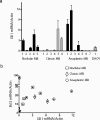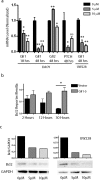Hedgehog signaling promotes medulloblastoma survival via Bc/II
- PMID: 17200206
- PMCID: PMC1762704
- DOI: 10.2353/ajpath.2007.060066
Hedgehog signaling promotes medulloblastoma survival via Bc/II
Abstract
Activation of the Hedgehog (Hh) pathway has been identified in several cancers, including medulloblastoma, but the mechanisms by which this pathway affects tumor survival and growth are incompletely understood. We investigated whether Hedgehog might promote survival of medulloblastoma cells via up-regulation of BclII. We found that mRNA levels of the Hedgehog pathway effector Gli1 were significantly associated with BclII expression in medulloblastoma and that Gli1 and BclII are both present in regions of decreased apoptosis in nodular medulloblastoma. Transient overexpression of Gli1 and Gli2 in medulloblastoma cultures induced a BclII transcriptional reporter and increased BclII protein levels, whereas stable overexpression of Gli1 was associated with increased BclII mRNA. The Hedgehog antagonist cyclopamine blocked expression of the Hh pathway targets PTCH1 and Gli1, lowered BclII levels, and increased apoptosis in DAOY and UW228 medulloblastoma cells. Apoptotic induction caused by cyclopamine could be rescued in part by enforced expression of Gli1 or BclII. Hh pathway blockade also sensitized medulloblastoma to the effects of the proapoptotic agent lovastatin. These data demonstrate that BclII is an important mediator of Hh activity in medulloblastoma and suggest new strategies for combined chemotherapeutic regimens.
Figures





Similar articles
-
Synergism between Hedgehog-GLI and EGFR signaling in Hedgehog-responsive human medulloblastoma cells induces downregulation of canonical Hedgehog-target genes and stabilized expression of GLI1.PLoS One. 2013 Jun 10;8(6):e65403. doi: 10.1371/journal.pone.0065403. Print 2013. PLoS One. 2013. PMID: 23762360 Free PMC article.
-
Hedgehog signaling negatively co-regulates BH3-only protein Noxa and TAp73 in TP53-mutated cells.Cancer Lett. 2018 Aug 10;429:19-28. doi: 10.1016/j.canlet.2018.04.025. Epub 2018 Apr 24. Cancer Lett. 2018. PMID: 29702195
-
β-Catenin-Gli1 interaction regulates proliferation and tumor growth in medulloblastoma.Mol Cancer. 2015 Feb 3;14(1):17. doi: 10.1186/s12943-015-0294-4. Mol Cancer. 2015. PMID: 25645196 Free PMC article.
-
New developments in medulloblastoma treatment: the potential of a cyclopamine-lovastatin combination.Expert Opin Investig Drugs. 2008 Feb;17(2):185-95. doi: 10.1517/13543784.17.2.185. Expert Opin Investig Drugs. 2008. PMID: 18230052 Review.
-
Hedgehog beyond medulloblastoma and basal cell carcinoma.Biochim Biophys Acta. 2010 Apr;1805(2):181-208. doi: 10.1016/j.bbcan.2010.01.003. Epub 2010 Jan 18. Biochim Biophys Acta. 2010. PMID: 20085802 Review.
Cited by
-
Increasing Ciliary ARL13B Expression Drives Active and Inhibitor-Resistant Smoothened and GLI into Glioma Primary Cilia.Cells. 2023 Sep 26;12(19):2354. doi: 10.3390/cells12192354. Cells. 2023. PMID: 37830570 Free PMC article.
-
Regulation of Cell Plasticity by Bromodomain and Extraterminal Domain (BET) Proteins: A New Perspective in Glioblastoma Therapy.Int J Mol Sci. 2023 Mar 16;24(6):5665. doi: 10.3390/ijms24065665. Int J Mol Sci. 2023. PMID: 36982740 Free PMC article. Review.
-
A statin-regulated microRNA represses human c-Myc expression and function.EMBO Mol Med. 2012 Sep;4(9):896-909. doi: 10.1002/emmm.201101045. Epub 2012 Aug 7. EMBO Mol Med. 2012. PMID: 22887866 Free PMC article.
-
Expression of Gli1 and PARP1 in medulloblastoma: an immunohistochemical study of 65 cases.J Neurooncol. 2011 Jul;103(3):459-67. doi: 10.1007/s11060-010-0431-2. Epub 2010 Oct 16. J Neurooncol. 2011. PMID: 20953661
-
Profile of vismodegib and its potential in the treatment of advanced basal cell carcinoma.Cancer Manag Res. 2013 Jul 31;5:197-203. doi: 10.2147/CMAR.S45976. Print 2013. Cancer Manag Res. 2013. PMID: 23940421 Free PMC article.
References
-
- Berman DM, Karhadkar SS, Hallahan AR, Pritchard JI, Eberhart CG, Watkins DN, Chen JK, Cooper MK, Taipale J, Olson JM, Beachy PA. Medulloblastoma growth inhibition by hedgehog pathway blockade. Science. 2002;297:1559–1561. - PubMed
-
- Berman DM, Karhadkar SS, Maitra A, Montes De Oca R, Gerstenblith MR, Briggs K, Parker AR, Shimada Y, Eshleman JR, Watkins DN, Beachy PA. Widespread requirement for Hedgehog ligand stimulation in growth of digestive tract tumours. Nature. 2003;425:846–851. - PubMed
-
- Karhadkar SS, Bova GS, Abdallah N, Dhara S, Gardner D, Maitra A, Isaacs JT, Berman DM, Beachy PA. Hedgehog signalling in prostate regeneration, neoplasia and metastasis. Nature. 2004;431:707–712. - PubMed
-
- Watkins DN, Berman DM, Burkholder SG, Wang B, Beachy PA, Baylin SB. Hedgehog signalling within airway epithelial progenitors and in small-cell lung cancer. Nature. 2003;422:313–317. - PubMed
Publication types
MeSH terms
Substances
Grants and funding
LinkOut - more resources
Full Text Sources
Other Literature Sources

